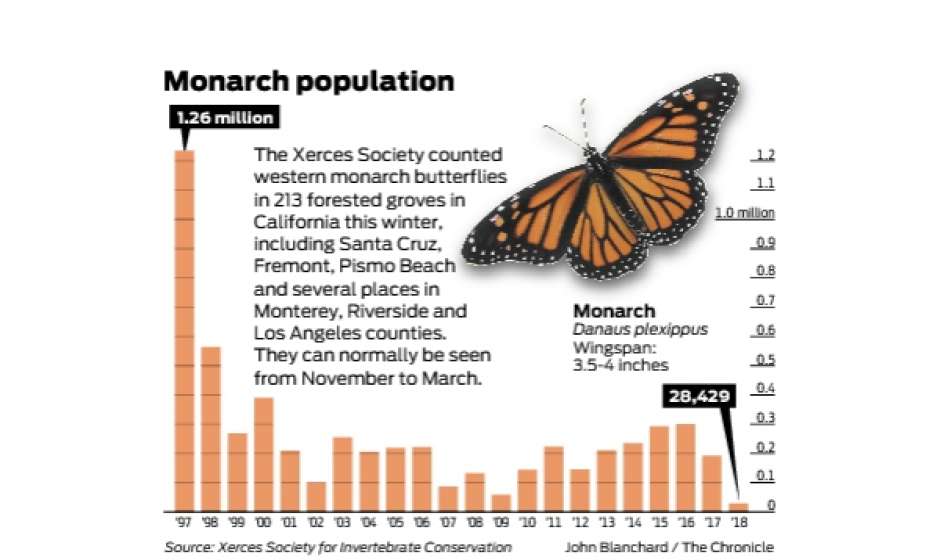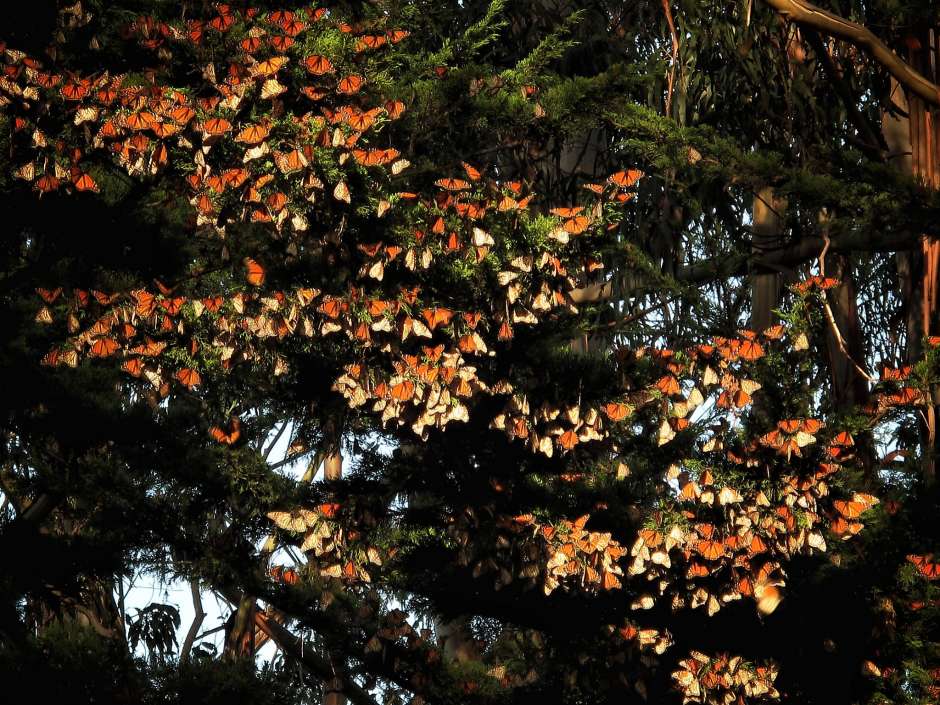There’s A New ‘Ghostbusters’ Movie Coming In 2020
First and foremost, here’s a thing we didn’t expect to be saying on the internet in 2019: There’s a new Ghostbusters movie on the horizon. Yes, it’s true. Ivan Reitman, who directed the 1984 original, is producing, and his son, Jason (Juno, Up in the Air), will cowrite and direct. No plot details are available yet, but it will take place in the same universe that the original proton-pack-wielding, ghostbusting foursome saved back in the 1980s. The film, which already has a teaser, is scheduled to hit theaters in summer 2020. Start working on your “Who ya gonna call?” jokes now.
Article via Wired
Reggie Bullock’s Tattoo Became A Teachable Moment On His LGBTQ Advocacy Journey
The Detroit Pistons’ small forward says he feels “blessed” to be a queer ally in professional sports.
Article via Huffingtonpost
California’s most famous butterfly nearing death spiral
An alarming, precipitous drop in the western monarch butterfly population in California this winter could spell doom for the species, a scenario that biologists say could also plunge bug-eating birds and other species into similar death spirals.
Only 28,429 of the striking orange-and-black butterflies were counted at 213 sites in California, an 86 percent drop from a year ago, according to the final tally of the annual Thanksgiving and New Year’s counts released Thursday by the Xerces Society for Invertebrate Conservation.
That’s a 99.4 percent decline since the 1980s, an all-time low for the Pacific Coast, where an estimated 10 million monarchs once blanketed trees from Marin County to the Baja California peninsula, providing, by all accounts, a spectacular winter display of color.

Scientists knew things were bad for the western monarch, but then “there was this other order of magnitude drop,” said Emma Pelton, a conservation biologist for the Xerces Society, an international nonprofit whose mission is to protect invertebrates and their habitats. “It’s mind-boggling. We’re now down below 1 percent of the historic population.”
The death of monarchs does not bode well for other insects, like bees, or bird species that make their living eating insects.
Monarchs in trouble
Western monarch butterflies spend the winter in more than 300 forested groves along the California coast, including large populations in Riverside and Los Angeles counties, Pacific Grove, Monterey and at Natural Bridges State Beach in Santa Cruz. They can normally be seen from November to March.
With the number of butterflies declining rapidly, here are four things governments and the public can do to help:
Protect and manage California overwintering sites.
Restore breeding and migratory habitat in California, particularly habitat along the coast range, foothills and Sacramento Valley.
Stop spraying pesticides and herbicides near milkweed, their primary habitat.
Protect, manage, and restore summer breeding and fall migration habitat outside of California.
“It is very apt to say this is a canary in a coal mine for a lot of our native pollinators,” Pelton said. “There’s a tight link in a loss of insects and our songbirds, which rely on insects. We have declines in songbirds, and I think that links directly to declines in insects.”
The die-off has been blamed on a variety of things, including urban sprawl, the spraying of pesticides and herbicides on corn and soybean crops, and the plowing under of the monarch’s milkweed habitat along their migratory route.
A University of Michigan experiment published in July found that higher carbon dioxide levels have reduced a natural toxin in milkweed that feeding monarch caterpillars utilize to fight off parasites. The study showed a 77 percent reduction in parasite tolerance in the butterflies hatched on milkweed grown under high concentrations of carbon dioxide, which comes from car and factory emissions and is what scientists say is the primary cause of climate change.
If nothing is done, Pelton said, the California butterflies, first observed by a Russian expedition looking for a passage across the Arctic Ocean in 1816, could be on an “extinction vortex,” a time when there are not enough butterflies left to recover.
Nobody knows how low the monarch population can go before it’s too late, but a 2017 study funded by The U.S. Fish and Wildlife Service and published in the journal Biological Conservation calculated that the point of no return would likely come when there are fewer than 30,000 butterflies.
The more abundant eastern monarchs, which spend their winters in Mexico instead of California, are famous because they cover whole sections of forest in a kaleidoscope of color. It is the largest insect migration in the world, but it too is in trouble. The eastern monarchs have declined more than 90 percent since 1996, when scientists estimated there were 1 billion nesting in the trees.
The journeys of both populations are remarkable in that it takes several generations of butterflies to make the six- to nine-month-long trek south for the winter. When they head back, starting in February or March, the mothers will die after laying eggs on milkweed, where the caterpillars grow up. Once they are ready to fly, the young butterflies somehow know where to go, without ever having even seen their mothers.
The California population is declining at an average of 7 percent a year, according to the 2017 Fish and Wildlife study. At the time, there were about 300,000 monarchs in California. That’s slightly worse than the 6 percent drop seen in the eastern monarch population.
“If this prediction is true, we are now below the quasi-extinction threshold,” Pelton said. “This is a crisis.”
There are two major migrations of monarch butterflies — the eastern and western populations — which scientists believe divide themselves at the Rocky Mountains when they head south for the winter from their summer homes in Canada and the Pacific Northwest.
In all, monarch populations in North America have plunged more than 95 percent since the 1980s, researchers have said.
Article via SFChronicle
Anti-vaxxers are among the WHO’s top 10 global health threats, and Ebola fake news is killing people
During an outbreak in the Democratic Republic of Congo, “as rumors surface, communications experts rebut them with accurate information via WhatsApp or local radio.”
Anti-vaxxers are one of the top 10 global health threats. The World Health Organization identified “vaccine hesitancy” — “the reluctance or refusal to vaccinate despite the availability of vaccines” — as one of its top 10 health concerns facing the world in 2019.
A 2018 study found that “philosophical-belief” vaccine non-medical exemptions have risen in 12 of the 18 states that allow them, and the authors noted:
While NMEs continue to rise in most of the 18 US states that allow them, several European countries, including France and Italy, as well as Australia, have taken measures to either make vaccines compulsory or even fine parents who refuse to vaccinate their children. Romania has experienced serious and large measles outbreaks and may also tighten vaccine legislation. Our concern is that the rising NMEs linked to the antivaccine movement in the US will stimulate other countries to follow a similar path. It would be especially worrisome if the very large low- and middle-income countries — such as Brazil, Russia, India, and China (the BRIC nations), or Bangladesh, Indonesia, Nigeria, and Pakistan — reduce their vaccine coverage. In such a case, we could experience massive epidemics of childhood infections that may threaten achievement of United Nations global goals.
Measles cases in Europe are at a 20-year high, The Guardian reported last month, topping 60,000 in 2018 per WHO — “more than double that of 2017 and the highest this century. There have been 72 deaths, twice as many as in 2017.” New York is facing its most severe measles outbreak in decades, with cases there concentrated almost exclusively among ultra-Orthodox Jews.
This week, Elsevier Atlas highlighted research that aims to help explain anti-vaccine attitudes. The study looked at the Dunning-Kruger effect — a form of cognitive bias in which people assume they know more than they actually do about an issue, or people’s “ignorance of their own ignorance” — surrounding vaccines. Matthew Motta, a postdoc at the Annenberg Public Policy Center at the University of Pennsylvania and is the lead author of of the study, explained:
We gave people a knowledge test about the causes of autism and then we asked people in a national survey: How much do you think you know about the causes of autism? We asked the same question about medical experts like doctors and scientists. We compared people’s perceptions of self to perceptions of experts and looked at that versus how well they scored on the knowledge test. We show there’s a relationship between knowledge and misinformation and what we call overconfidence — the belief that you know more. As we showed, those who are the least knowledgeable and most misinformed were most likely to exhibit overconfidence. Once we did that, we looked at policy implications of overconfidence. We looked at the correlation between attitudes, for example, about whether it should be required to vaccinate kids going to public school. Those who were the most overconfident were less likely to think that was the case.
The researchers, in a survey of 1,300 U.S. adults, found that “more than a third of study participants believe they knew as much as or more than medical doctors and scientists about the causes of autism,” and that while they trusted information from experts, they also “place high levels of trust on information from non-experts (42 percent) and feel that non-experts should play a major policymaking role (38 percent).”
“We need efforts to inform people, but we also need to debunk misinformation. Hitting people over the head with facts probably isn’t going to do that,” Motta said. “What it might look like is the subject of follow-up studies. That’s the key question: how can we combat misinformation about vaccines?”
“More transparent — in some cases literally.” In Science Magazine, author and science journalist Laura Spinney reports on how rumors and hoaxes are making the battle against an Ebola outbreak in the Democratic Republic of Congo more difficult — and how public health workers have launched an unprecedented effort to fight misinformation.
For the first time in an Ebola outbreak, UNICEF and other agencies have joined forces as a single response team, which answers to the DRC’s Ministry of Health and includes dozens of social scientists, who use the airwaves, social media, and meetings with community and religious leaders to fight misinformation. Responders also foster trust by making their work more transparent — in some cases literally. A new biosecure tent, called the Biosecure Emergency Care Unit for Outbreaks (CUBE), allows relatives to visit and see Ebola patients during treatment.
Here’s some of what the social scientists are doing:
Part of their role is to chart the social networks through which the virus spreads, but they also gather information about communities’ perceptions, which is entered within days into an online “dashboard” created by the International Federation of Red Cross and Red Crescent Societies (IFRC) in Geneva. The government has also recruited young people to report misinformation circulating on WhatsApp, a major information channel in the DRC, says Jessica Ilunga, a spokesperson for the DRC’s Ministry of Health in Kinshasa.
As rumors surface, communications experts rebut them with accurate information via WhatsApp or local radio. They take care not to repeat the misinformation; research has shown this is the best way to help the public “forget” false news and reinforce the truth. The vocal support of Ebola survivors has helped as well. Grateful for their care, some have become volunteers at Ebola treatment centers (ETCs).
And the BBC’s Yvonne McPherson, director of BBC Media Action USA, wrote in December about her work as BBC Media Action’s Ebola response efforts. There’s a difference, she explains, between “acute and chronic misinformation problems.” An example of an acute misinformation problem, for instance, was a 2014 rumor that you could avoid Ebola by bathing in salt water.
The salt water Ebola example was a real life case of acute misinformation in West Africa. News reports tracked this rumor to a text message from a student in Nigeria. It spread immediately to social media, with hundreds of tweets repeating the rumor in the following couple of days. In just as many days, the Nigerian Ministry of Health, the World Health Organization and others corrected it across traditional and social media, and the rumor was quashed. Sadly, this misinformation was responsible for at least two deaths and many people were hospitalized due to excessive consumption of salt water.
That’s an acute scenario: where misinformation spreads rapidly, then is corrected by multiple trusted sources and goes away.
But chronic misinformation is even trickier:
A chronic misinformation example would be the belief or suspicion that vaccines are harmful. It is chronic because this misinformation persists over years despite available facts to the contrary.
Algorithms, and the market forces underpinning them, are designed to capture attention, and in turn provide a breeding ground for misinformation to spread. Tweaking algorithms to direct people away from non-credible sources or annotating articles with credibility warnings may be part of a solution; however, these efforts do not address the longstanding beliefs people may already have about a health issue.
Article via niemanlab.org
Man Charged With Murder in Fatal Assault of Girlfriend’s 2-Year-Old Son in Westchester
An Inglewood man accused of killing his girlfriend’s young son two days before his birthday last summer has been charged with murder, prosecutors announced Thursday.
Josafat Bonifacio, 27, also faces a count of assault on a child causing death, according to a news release from the Los Angeles County District Attorney’s Office.
The incident took place on July 3 at a home near the 8700 block of Croydon Avenue in Westchester. Bonifacio had been caring for 2-year-old Damien Ventura — his girlfriend’s son — and his 4-year-old daughter when someone called 911 during the evening, officials said.
The little boy was rushed to Ronald Reagan UCLA Medical Center in Westwood where he died. Damien had suffered from multiple injuries, the release stated.
The Los Angeles Police Department responded to the hospital to investigate the boy’s death.
Damien died two days before his third birthday, according to a GoFundMe page to raise money for his funeral.
Bonifacio was arrested on Tuesday and is being held on $3 million bail, inmate records show.
The defendant faces a maximum sentence of 25 years to life in prison if convicted.
He’s scheduled to be arraigned sometime on Thursday.
The case is being prosecuted by the office’s Family Violence Division, Complex Child Abuse Section.
Man’s attempt to treat back pain with semen injections goes horribly wrong
A nutty Irishman landed in the hospital after he took matters into his own hands to treat his back pain – by injecting himself with his own semen, according to a report.
After injecting himself monthly for a year and a half, the unidentified 33-year-old developed a subcutaneous abscess in his arm, as well as emphysema and edema – excess fluid – under his skin, the Irish Times reported.
The man said he had been injecting his own semen, without medical advice, as an “innovative” method to treat his lower back pain.
He revealed that he injected one monthly “dose” of semen for 18 consecutive months using a hypodermic needle he bought online.
The patient was treated with an intravenous antimicrobial drip, but he decided to discharge himself without allowing doctors to drain the “local collection,” the news outlet reported.
The case was revealed in a report published by the Irish Medical Journal titled, “Semenly Harmless Back Pain: An Unusual Presentation of a Subcutaneous Abscess.”
Dr. Lisa Dunne of Adelaide and Meath Hospital in Tallaght, who authored the case report, found that there were no other reported cases of intravenous semen injection to be found anywhere in medical literature.
Woman poses as non-existent autistic twin sister, tries to sexually assault caregiver
There’s crazy, and then there’s posing as your autistic twin sister who doesn’t exist crazy.
Cops say that’s exactly what Rachel Childs, of Pearland, Texas, did earlier this month in an attempt to sexually assault a private caregiver.
According to local police, the 29-year-old solicited the individual “under the pretense of caring Ms. Childs’ twin sister” who was described as having autism.
The unidentified worker was asked to arrive at the 29-year-old’s home “at a specific time” but told that she — Childs — would not be present.
Cops say the caregiver was given further instructions to “take the autistic twin sister to her home and then return her the next morning.” Childs allegedly claimed she would arrive a short time later.
“During the stay at the caregiver’s home, the ‘sister’ engaged in sexually oriented conduct toward the caregiver who became suspicious as her behavior did not reflect that of someone who was autistic,” said Pearland Police in a statement Thursday. “As a result, the caregiver investigated and determined that Ms. Childs was an only child and contacted the Pearland Police Department.”
Cops launched an investigation and quickly found out that Childs — who isn’t autistic — was trying to pull of an elaborate hoax “for sexual gratification” and was actually the “sister” that the caregiver was hired to take care of. She turned herself in after the Jan. 3 incident, but now cops are worried she may have tricked others.
“The Pearland Police Department believe there might be additional persons whom were similarly deceived by Ms. Childs,” officials said.
Anyone with information has been asked to contact Pearland detectives.











